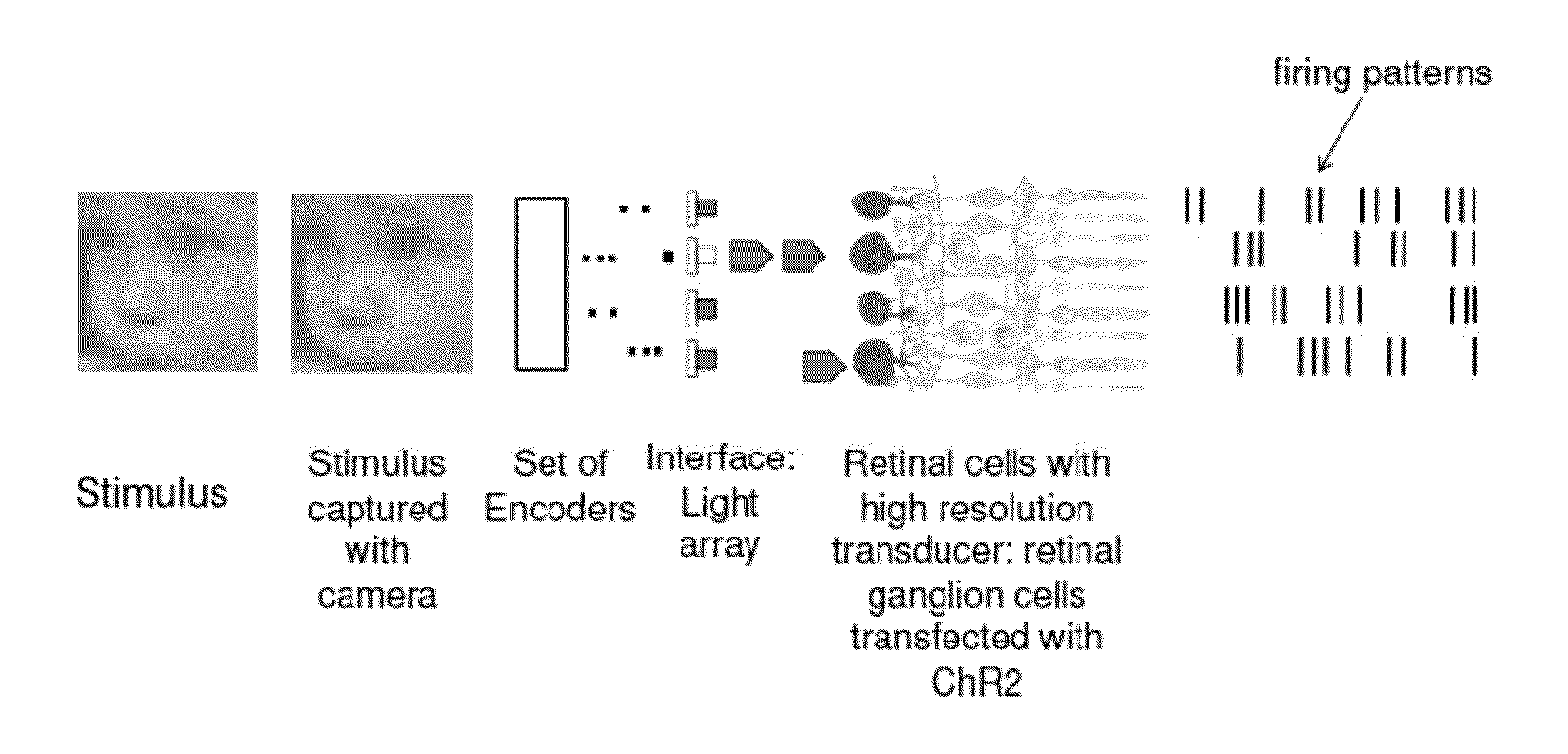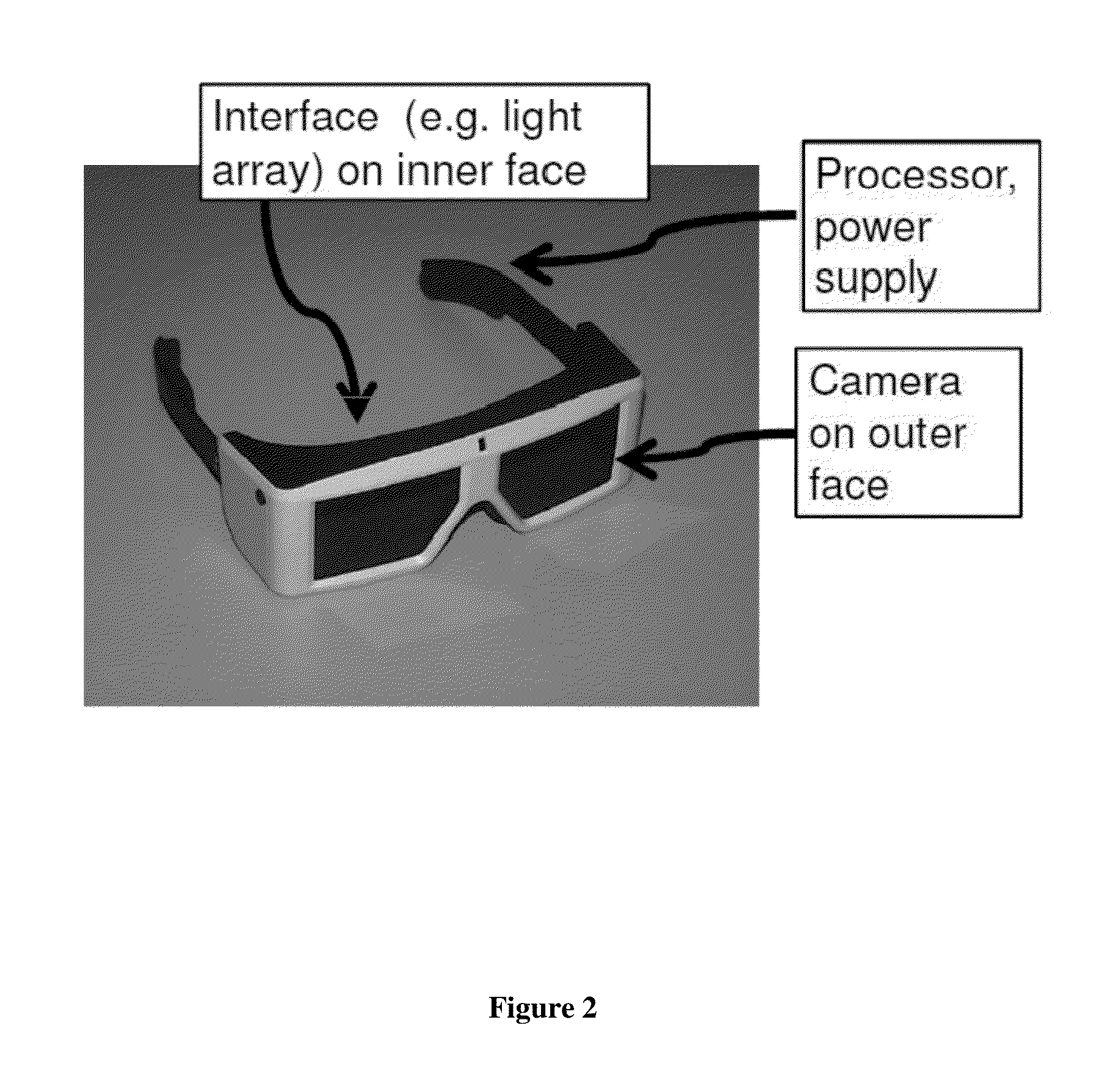Retina prosthesis
a retinal prosthesis and prosthesis technology, applied in the field of retinal prosthesis, can solve the problems of not being able to the device performance is still limited, and the current technology cannot achieve the resolution of the normal retina, so as to maximize the likelihood, maximize the likelihood, and avoid local maxima
- Summary
- Abstract
- Description
- Claims
- Application Information
AI Technical Summary
Benefits of technology
Problems solved by technology
Method used
Image
Examples
example 1
Method of Building the Encoders
Constructing the Encoders Using an Linear-Nonlinear-Poisson (LNP) Cascade
[0226]The parameters for the encoders were constructed from the responses to two sets of stimuli: binary spatio-temporal white noise (WN) and a grayscale natural scene movie (NS) recorded in New York City's Central Park. Both stimuli were presented at a frame rate of 15 Hz, and had the same mean luminance (0.24 μW / cm2 on the retina) and contrast (root-mean-squared (RMS) contrast was 0.087 μW / cm2). For the preprocessing step, we chose a=0, and b=255 / 0.48 μW / cm2, so that the visual stimuli are mapped into the numerical range 0-255 (as described above in section entitled, “Encoders”.
[0227]To determine the spatiotemporal transformation, we used a linear-nonlinear model as described above in the same section (see also, Victor and Shapley 1979; Paninski et al. 2007; Pillow et al. 2008; Nirenberg et al. 2010). Parameters for the model were determined by maximizing the likelihood that the...
example 2
Determining the Parameters for the Spatiotemporal Transformation
[0235]We describe a procedure to determine the parameters for the spatiotemporal transformations. Parameters discussed are as in the section “Encoders” above.
[0236]In this example, first, the experiment is performed, and ganglion cell responses to WN and NS stimuli are collected (see “Example 1—Method of Building the Encoders” for an example of stimuli). Next, the reverse correlation between the ganglion cell action potential times and the stimulus intensity is calculated, to determine a starting set of values for the linear filter Lm. Next, the linear filter is assumed to be separable, a product of a spatial function and a temporal function. The spatial function is parameterized as a 10 by 10 grid of weights, and the temporal function is parameterized as the sum of 10 weighted temporal basis functions. At this stage, the nonlinearity Nm is assumed to be an exponential function to ensure there are no local maxima. Next,...
example 3
Comparison of Amount of Information Carried by Virtual Retinal Cell and Real Retinal Cell
[0237]To build the data set, we recorded the responses of several hundred mouse retinal ganglion cells (515 cells) to a broad range of stimuli, including natural and artificial stimuli, which for this experiment was checkerboard, natural scenes, and drifting gratings. For each cell, we constructed its encoder (also referred to as its virtual retinal cell, or model cell). This was achieved as follows. We presented WN (white noise) and NS (natural or naturalistic stimuli) stimuli to retinas and recorded the responses of the ganglion cells and parameterized the stimulus / response relationship for each cell, as described above. We then tested the encoders using additional natural scene and drifting grating responses. Thus, all tests were performed using novel stimuli.
[0238]FIG. 3 shows the results of the information analysis. We recorded from several hundred ganglion cells and modeled their responses...
PUM
 Login to View More
Login to View More Abstract
Description
Claims
Application Information
 Login to View More
Login to View More - R&D
- Intellectual Property
- Life Sciences
- Materials
- Tech Scout
- Unparalleled Data Quality
- Higher Quality Content
- 60% Fewer Hallucinations
Browse by: Latest US Patents, China's latest patents, Technical Efficacy Thesaurus, Application Domain, Technology Topic, Popular Technical Reports.
© 2025 PatSnap. All rights reserved.Legal|Privacy policy|Modern Slavery Act Transparency Statement|Sitemap|About US| Contact US: help@patsnap.com



